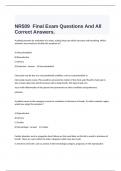NR509 Final Exam Questions And All
Correct Answers.
A patient presents for evaluation of a sharp, aching chest pain which increases with breathing. Which
anatomic area would you localize the symptom to?
A) Musculoskeletal
B) Reproductive
C) Urinary
D) Endocrine - Answer A) Musculoskeletal
Chest pain may be due to a musculoskeletal condition, such as costochondritis or
intercostal muscle cramp. This would be worsened by motion of the chest wall. Pleuritic chest pain is
also a sharp chest pain which increases with a deep breath. This type of pain can
occur with inflammation of the pleura from pneumonia or other conditions and pulmonary
embolus.
A patient comes to the emergency room for evaluation of shortness of breath. To which anatomic region
would you assign the symptom?
A) Reproductive
B) Urinary
C) Cardiac
D) Hematologic - Answer C) Cardiac
Cardiac disorders such as congestive heart failure are the most likely on this list to result in shortness of
breath. There are cases within the other categories which may also result
in shortness of breath, such as anemia in the hematologic category, pregnancy in the reproductive
,category, or sepsis with UTI in the urinary category.
A patient presents for evaluation of a cough. Which of the following anatomic regions can be responsible
for a cough?
A) Ophthalmologic
B) Auditory
C) Cardiac
D) Endocrine - Answer C) Cardiac
The cardiac system can cause a cough if the patient has congestive heart failure. This results in fluid
buildup in the lungs, which in turn can cause a cough that produces pink,
frothy sputum. A foreign body in the ear may also cause a cough by stimulating Arnold's branch of the
vagus nerve, but this is less likely to be seen clinically than heart failure.
A 22-year-old advertising copywriter presents for evaluation of joint pain. The pain is new,
located in the wrists and fingers bilaterally, with some subjective fever. The patient denies a
rash; she also denies recent travel or camping activities. She has a family history significant for
rheumatoid arthritis. Based on this information, which of the following pathologic processes
would be the most correct?
A) Infectious
B) Inflammatory
C) Hematologic
D) Traumatic - Answer B) Inflammatory
The description is most consistent with an inflammatory process, although all the other etiologies should
be considered. Lyme disease is an infection which commonly causes
arthritis, hemophilia is a hematologic condition which can cause bleeding in the joints, and trauma can
obviously cause joint pain.
,A 47-year-old contractor presents for evaluation of neck pain, which has been intermittent for several
years. He normally takes over-the-counter medications to ease the pain, but this time they haven't
worked as well and he still has discomfort. He recently wallpapered the entire second floor in his house,
which caused him great discomfort. The pain resolved with rest. He denies fever, chills, rash, upper
respiratory symptoms, trauma, or injury to the neck. Based on this description, what is the most likely
pathologic process?
A) Infectious
B) Neoplastic
C) Degenerative
D) Traumatic - Answer C) Degenerative
The description is most consistent with degenerative arthritis in the neck. The
patient has had intermittent symptoms and the questions asked to elicit pertinent negative and
positive findings are negative for infectious, traumatic, or neoplastic disease.
A 15-year-old high school sophomore comes to the clinic for evaluation of a 3-week history
of sneezing; itchy, watery eyes; clear nasal discharge; ear pain; and nonproductive cough. Which
is the most likely pathologic process?
A) Infection
B) Inflammation
C) Allergic
D) Vascular - Answer C) Allergic
This description is most consistent with allergic rhinitis.
A 19-year old-college student presents to the emergency room with fever, headache, and
neck pain/stiffness. She is concerned about the possibility of meningococcal meningitis.
, Several of her dorm mates have been vaccinated, but she hasn't been. Which of the following
physical examination descriptions is most consistent with meningitis?
A) Head is normocephalic and atraumatic, fundi with sharp discs, neck supple with full range
of motion
B) Head is normocephalic and atraumatic, fundi with sharp discs, neck with paraspinous
muscle spasm and limited range of motion to the right
C) Head is normocephalic and atraumatic, fundi with blurred disc margins, neck tender to
palpation, unable to perform range of motion
D) Head is normocephalic and atraumatic, fundi with blurred disc margins, neck supple with
full range of motion - Answer C) Head is normocephalic and atraumatic, fundi with blurred disc
margins, neck tender to
palpation, unable to perform range of motion
Blurred disc margins are consistent with papilledema, and neck tenderness and lack of range of motion
are consistent with neck stiffness, which in this scenario is likely to be caused
by meningeal inflammation. Kernig's and Brudzinski's signs are also helpful in testing for meningeal
irritation on exam.
A 37-year-old nurse comes for evaluation of colicky right upper quadrant abdominal pain. The pain is
associated with nausea and vomiting and occurs 1 to 2 hours after eating greasy foods. Which one of the
following physical examination descriptions would be most consistent with the diagnosis of cholecystitis?
A) Abdomen is soft, nontender, and nondistended, without hepatosplenomegaly or masses.
B) Abdomen is soft and tender to palpation in the right lower quadrant, without rebound or
guarding.
C) Abdomen is soft and tender to palpation in the right upper quadrant with inspiration, to the
point of stopping inspiration, and there is no rebound or guarding.
D) Abdomen is soft and tender to palpation in the mid-epigastric area, without rebound or
guarding. - Answer C) Abdomen is soft and tender to palpation in the right upper quadrant with
inspiration, to the




